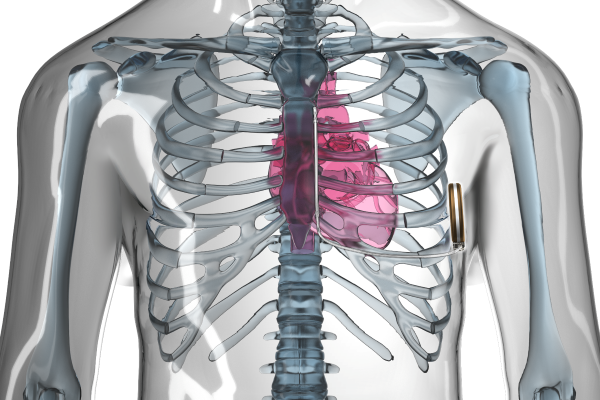What is sudden cardiac arrest and how does an implantable defibrillator help?

The heart is more than just a hard-working muscle – it’s also its own power source. That’s right: The heart generates its own electricity to keep itself pumping. Located in the walls of the heart are specialized cells, called the cardiac conduction system, that generate a small electrical current. That electricity activates and regulates the heartbeat, creating a steady rhythm that pushes blood smoothly through the body.
A problem within the heart’s electrical system, however, can disrupt that rhythm and hamper the heart’s pumping ability. In rare but catastrophic instances, faulty or erratic electrical activity in the heart can cause sudden cardiac arrest (SCA).
Sudden cardiac arrest is not the same thing as a heart attack, which is caused by blockages that prevent proper blood flow. Rather, SCA is an urgent, life-threatening event in which the heart stops beating in any meaningful way. Without any blood flow within the body, the SCA victim falls instantly unconscious. The only hope for survival is if bystanders immediately intervene with CPR and an automatic external defibrillator, an emergency device often located in offices and public buildings. But because SCA happens so quickly, and typically without warning, treatment usually arrives too late. Nearly 90% of people stricken by SCA do not survive.
Fortunately, for those at risk for SCA, there is a way to protect against dying from sudden cardiac arrest: with an implantable cardioverter defibrillator, also called an ICD.
What is an ICD?
An implantable cardioverter defibrillator is a small device that monitors the heart rhythm 24 hours a day to prevent sudden cardiac arrest. If the ICD detects an abnormal rhythm, it sends out an electrical shock to correct it. In that sense, it’s similar to a pacemaker, which is also designed to control the heart’s rhythm - but whereas a pacemaker corrects an abnormally slow heart rhythm by delivering painless electrical pulses, an ICD sends a shock if it detects a dangerously fast rhythm that can be the precursor to sudden cardiac death. With an implantable defibrillator, more than 95 percent of people who have sudden cardiac arrest outside the hospital survive.[1][2]
A doctor may recommend an ICD if they’ve determined a patient is at risk for sudden cardiac arrest. Risk factors include:
- Heart disease. Having a heart condition, such as an irregular rhythm (arrhythmia), is the single biggest risk factor.
- Race. Studies have found Black people are twice as likely to suffer sudden cardiac arrest as Caucasians.
- Gender. Men make up more than 60% of occurrences.
Back in the 1980s, when ICD devices were first introduced, they were implanted in a person’s abdomen. Later came the transvenous ICD (TV-ICD), which is implanted near the left collarbone, with leads – the wires that deliver the shock – fed through a vein and placed inside the heart. The newest and least invasive type is the subcutaneous ICD (S-ICD), like the unique EMBLEM™ MRI S-ICD System, which is implanted under the skin of the lower left ribs and delivers protection without touching the heart. As a result, it significantly reduces a number of potentially serious short- and long-term risks associated with placing electrical wires inside the heart or blood vessels, such as life-threatening infection.
Living with an ICD
The procedure to implant the EMBLEM MRI S-ICD is minimally invasive and generally takes an hour. A doctor makes an incision under the left armpit and inserts the device, which is a small, flat disc. A lead is then implanted just above the breastbone, along with an electrode that links the lead to the device. The heart and blood vessels are left untouched and intact. Generally, patients return home the next day and are fully able to resume their normal activities in four to six weeks.
Whether someone chooses to get an ICD or an S-ICD, there are no noticeable sensations when the device is monitoring the heart. However, if the device detects a life-threatening heart rhythm, the experience of receiving a high-energy shock can be very noticeable, so it’s helpful to know what one might expect.
Many patients feel nothing when the electrical shock is delivered, because they’ve fallen unconscious when their heart entered a dangerous rhythm. Patients who remain conscious sometimes feel the shock as a brief, sudden “kick in the chest” sensation. While that jolt can be surprising or even painful, it is also over in an instant – and brings the relief of knowing that the device may have just saved your life.
Learn more about the causes, risk factors and treatment options for sudden cardiac arrest.
[1] Goldenberg I, Gillespie J, Moss AJ, et al. Long-term benefit of primary prevention with an implantable cardioverter-defibrillator: An extended 8-year follow-up study of the Multicenter Automatic Defibrillator Implantation Trial II. Circulation. 2010 Sep 28;122(13):1265–71.
[2] Bardy GH, Lee KL, Mark DB, et al. Amiodarone or an implantable cardioverter-defibrillator for congestive heart failure. N Engl J Med. 2005 Jan 20; 352(3): 225–37.